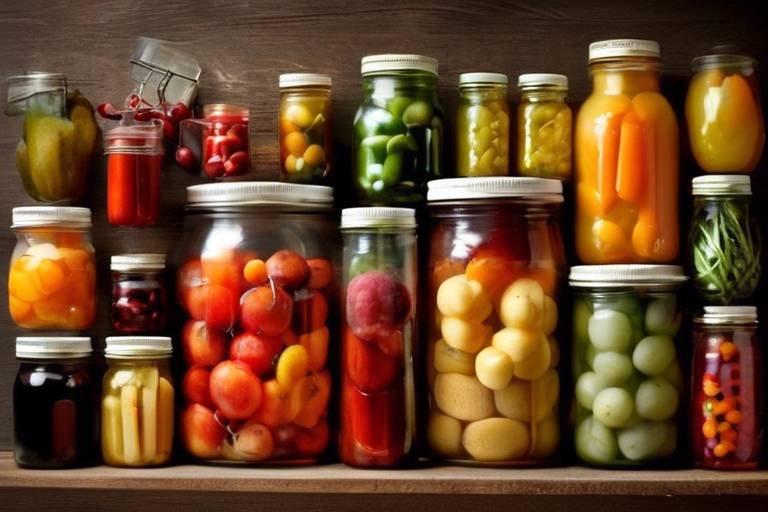The Physics of Thermal Expansion - Everyday Examples
Have you ever wondered why the metal expansion joints on bridges look so peculiar? Or why the train tracks seem to have gaps? These are all fascinating examples of thermal expansion—a concept that impacts our daily lives more than we might realize. In this article, we will dive deep into the principles of thermal expansion, its various types, and how they manifest in everyday scenarios. By the end, you’ll have a clearer understanding of how temperature changes can lead to significant transformations in materials and objects around us.
Thermal expansion is a physical phenomenon that occurs when materials change their dimensions in response to variations in temperature. As the temperature increases, most materials expand, while they contract when cooled. This principle is rooted in the behavior of atoms and molecules; as they gain energy from heat, they move more vigorously, causing the material to take up more space. Understanding thermal expansion is crucial for engineers, architects, and manufacturers, as it helps in designing structures and products that can withstand temperature fluctuations without failing. Imagine a world where bridges buckle or pipes burst due to heat—thermal expansion principles help us avoid such disasters!
There are three primary types of thermal expansion: linear, area, and volumetric. Each type describes how materials expand in different dimensions. Understanding these types allows us to predict how materials will behave under temperature changes, which is essential in various practical applications. Let’s explore each type in detail.
Linear expansion refers to the change in length of an object as it heats or cools. This phenomenon is particularly important in construction and engineering. For example, when a metal rod is heated, it expands in length. This is not just a theoretical concept; it has real-life applications that are critical for safety and functionality.
Bridges are prime examples of structures that must account for linear expansion. Engineers incorporate expansion joints into bridge designs to allow for the expansion and contraction of materials due to temperature changes. These joints are like flexible gaps that absorb the stress caused by thermal expansion, ensuring that the bridge remains stable and safe for use. Without these joints, the bridge could suffer from structural damage, leading to potential hazards for vehicles and pedestrians alike.
Similarly, railway tracks are designed with thermal expansion in mind. As temperatures rise, the metal tracks expand, and if there isn’t enough space for this expansion, the tracks can buckle, creating dangerous conditions for trains. Engineers use various methods, such as installing expansion gaps and using specific materials that can withstand temperature variations, to ensure that the tracks remain safe and functional. It’s a delicate balance that requires precise engineering and foresight.
Area expansion involves the increase in surface area of materials when heated. This type of expansion is particularly relevant in manufacturing processes, where materials like metals expand when heated before being shaped or molded. For instance, when metal sheets are heated, they not only get longer but also wider, which can affect how they fit together in assembly. This is why manufacturers must consider thermal expansion in their designs to avoid issues during production.
Volumetric expansion deals with the increase in volume of substances, especially liquids and gases. This type of expansion is significant in various fields, including meteorology, engineering, and even everyday activities like cooking. When you heat a substance, it not only expands in length or area but also in volume, which can lead to fascinating phenomena.
When liquids are heated, they expand and can overflow from their containers. This is a common occurrence in kitchens when boiling water. If you’ve ever noticed a pot of boiling water bubbling over, you’ve witnessed volumetric expansion in action! Designers of containers must account for this expansion to prevent spills and accidents, ensuring that containers have enough capacity to handle the increased volume without overflowing.
Gases expand significantly with temperature increases, which has a profound impact on atmospheric pressure. As the temperature rises, gas molecules move faster and spread out, leading to changes in pressure that can affect weather patterns. This is why meteorologists pay close attention to temperature changes; understanding thermal expansion in gases helps them predict weather phenomena like storms and heatwaves.
- What is thermal expansion? Thermal expansion is the increase in size of a material as its temperature increases.
- Why is thermal expansion important? It is crucial for ensuring the safety and functionality of structures and systems that experience temperature changes.
- How do engineers manage thermal expansion? Engineers use expansion joints, specific materials, and design considerations to accommodate thermal expansion in their projects.

Understanding Thermal Expansion
Thermal expansion is a fascinating phenomenon that occurs when materials change their dimensions in response to temperature variations. Imagine a balloon filled with air; as you heat it up, the air molecules inside move faster and spread apart, causing the balloon to expand. This is essentially what happens with most materials when they are subjected to heat. The principle behind thermal expansion is rooted in the kinetic theory of matter, which states that the energy of particles increases with temperature, leading to greater movement and, consequently, an increase in size.
In everyday life, thermal expansion is not just a scientific curiosity; it plays a crucial role in various applications and structures. For instance, when you heat a metal rod, it doesn't just get warmer; it actually becomes longer. This can have significant implications in construction and manufacturing, where precise measurements are critical. Understanding how different materials react to temperature changes can help engineers design safer and more efficient structures. For example, if a bridge or a railway track is built without considering thermal expansion, it could lead to catastrophic failures due to buckling or cracking.
Moreover, thermal expansion is not uniform across all materials. Different materials expand at different rates, which engineers must consider when selecting materials for specific applications. The coefficient of thermal expansion (CTE) quantifies how much a material will expand per degree of temperature change. Some materials, like metals, have higher CTEs, while others, like glass, expand less. This is why you might notice that metal objects feel much hotter than glass objects at the same temperature; they are expanding more and thus are more affected by temperature changes.
To illustrate, let's take a closer look at some common materials and their coefficients of thermal expansion:
| Material | Coefficient of Thermal Expansion (×10-6 /°C) |
|---|---|
| Steel | 11-13 |
| Aluminum | 22-24 |
| Glass | 8-10 |
| Copper | 16-17 |
In summary, understanding thermal expansion is essential for anyone involved in engineering, construction, or even just curious about the world around them. It helps us grasp why certain materials behave the way they do under temperature changes and highlights the importance of accounting for these changes in design and construction. So, the next time you observe a metal object expanding or a bridge's expansion joint, you'll appreciate the intricate dance of molecules at play and the careful planning that goes into creating safe and functional structures.

Types of Thermal Expansion
When we talk about thermal expansion, we're diving into a fascinating world where materials respond to heat in different ways. This phenomenon is not just a scientific curiosity; it has real-world implications that affect everything from the bridges we drive over to the pipes in our homes. In essence, thermal expansion can be categorized into three main types: linear expansion, area expansion, and volumetric expansion. Each type plays a unique role in how materials behave under temperature changes, and understanding these differences can help us appreciate the engineering marvels that surround us.
Linear expansion is perhaps the most straightforward of the three. It refers to the change in length of an object as it heats or cools. Imagine a metal rod placed over a flame; as it heats up, it stretches. This is not just a theoretical concept; it has practical applications in everyday structures. For instance, bridges and railway tracks are designed with this principle in mind to ensure safety and functionality. If we don’t account for linear expansion, we could end up with serious structural issues.
Next, we have area expansion, which involves the increase in surface area of materials when heated. This type of expansion is particularly noticeable in metals. For example, when metal sheets are heated during manufacturing processes, they expand in area, which can affect how they fit together in assemblies. This is crucial in industries where precision is key, such as aerospace and automotive manufacturing. Understanding area expansion helps engineers design components that can withstand temperature changes without compromising integrity.
Finally, let’s explore volumetric expansion, which deals with the increase in volume of substances, especially liquids and gases. This type of expansion is particularly significant in meteorology and engineering. For instance, when you heat a liquid in a container, it expands and can overflow if the container isn’t designed to accommodate this expansion. Similarly, gases expand significantly with temperature increases, impacting atmospheric pressure and influencing weather patterns. Understanding how gases behave under thermal expansion is essential for predicting environmental phenomena.
To summarize, the three types of thermal expansion—linear, area, and volumetric—are fundamental concepts that help us understand how materials interact with temperature changes. Each type has its own set of implications and applications, making it essential for engineers and designers to consider these factors in their work. Whether it's ensuring the safety of a bridge or designing a container for liquids, thermal expansion is a crucial aspect of material science.

Linear Expansion
Linear expansion is a fascinating phenomenon that occurs when materials change their length in response to temperature variations. Imagine a metal rod sitting in the sun; as it heats up, it expands, stretching ever so slightly. This change, although often imperceptible to the naked eye, can have significant implications in various fields, especially in engineering and construction. The importance of understanding linear expansion cannot be overstated, as it plays a crucial role in the design and safety of structures we encounter daily.
One of the most striking real-life applications of linear expansion is seen in the construction of bridges. When temperatures rise, the materials used in bridge construction, typically steel or concrete, expand. If this expansion is not accounted for, it can lead to serious structural issues. That's where expansion joints come into play. These joints are specifically designed to absorb the changes in length that occur due to temperature fluctuations. They ensure that the bridge remains safe and functional, regardless of the weather conditions.
Another prime example of linear expansion is found in railway tracks. Trains are heavy and travel at high speeds, so the integrity of the tracks is paramount. As temperatures increase, the steel tracks can expand significantly. If engineers do not take this into consideration, the tracks can buckle, creating dangerous conditions for trains. To mitigate this risk, engineers employ various techniques:
- Proper spacing between track sections
- Using flexible materials that can accommodate some expansion
- Regular maintenance checks to ensure that the tracks remain in good condition
In summary, linear expansion is not just a scientific concept; it is a vital consideration in the construction and maintenance of everyday structures. Understanding how materials respond to temperature changes helps engineers design safer and more reliable infrastructures. Whether it’s a bridge or a railway track, the principles of linear expansion are at work, silently ensuring that we can travel safely and efficiently.

Bridges and Expansion Joints
When we think about bridges, we often marvel at their grandeur and the engineering prowess that allows them to span vast distances. However, what many people don’t realize is that beneath this impressive structure lies a crucial component that ensures the safety and longevity of the bridge: expansion joints. These joints are designed to accommodate the natural thermal expansion and contraction that occurs due to temperature fluctuations. Just like a rubber band stretches and shrinks with heat, materials in a bridge also change dimensions, albeit on a much larger scale.
Expansion joints serve as a flexible connection between different sections of a bridge. They allow for movement without compromising the structural integrity of the bridge itself. Imagine trying to fit a long, hot spaghetti noodle into a cold bowl; if the noodle expands and the bowl doesn’t allow for that change, something’s gotta give! In the case of bridges, if these joints were absent, the stress caused by thermal expansion could lead to cracks or even catastrophic failures.
These joints come in various types, each designed for specific applications and environmental conditions. Some of the most common types include:
- Sliding Joints: These allow for horizontal movement and are often used in long-span bridges.
- Modular Joints: These are made up of multiple sections that can move independently, ideal for bridges with complex designs.
- Finger Joints: Named for their finger-like appearance, these joints accommodate both horizontal and vertical movement.
One of the most fascinating aspects of expansion joints is their ability to absorb not just thermal expansion but also the vibrations caused by traffic. Think about the constant rhythm of vehicles crossing a bridge; without expansion joints, the structure would endure relentless stress, potentially leading to structural fatigue. Engineers meticulously calculate the expected expansion and contraction of materials based on local climate data, ensuring that the joints can handle the worst-case scenarios.
In addition to thermal expansion, bridges also face other forces like wind, seismic activity, and even the weight of the vehicles that traverse them. Expansion joints are designed to work in harmony with these forces, allowing for a smooth, safe experience for all who cross. The next time you drive over a bridge, take a moment to appreciate these unsung heroes of engineering that silently work to keep you safe!
Q: What are expansion joints made of?
A: Expansion joints are typically made from durable materials such as rubber, metal, or composite materials designed to withstand the stresses of temperature changes and traffic loads.
Q: How often do expansion joints need to be inspected?
A: Regular inspections are crucial, usually every few years, or after significant weather events, to ensure they are functioning properly and to prevent potential structural damage.
Q: Can expansion joints fail?
A: Yes, like any component, expansion joints can fail due to wear and tear, improper installation, or extreme weather conditions. Regular maintenance is essential to identify and rectify any issues.

Railway Tracks
When it comes to railway tracks, the concept of thermal expansion is not just a theoretical idea; it's a real-world challenge that engineers must address to ensure safety and efficiency in train travel. As temperatures fluctuate, the metal rails expand and contract, which can lead to significant issues if not properly managed. Imagine a hot summer day when the sun beats down on those steel tracks; they can expand up to several inches! This change in length might seem trivial, but it can create dangerous conditions if the tracks are not designed to accommodate this expansion.
To mitigate the risks associated with thermal expansion, railway engineers implement several clever solutions. One common method is the use of expansion joints, which are specially designed gaps in the track that allow for movement without compromising structural integrity. These joints are crucial because they help to absorb the stress caused by the expansion of the rails. Without these joints, tracks could buckle under the pressure, leading to potential derailments or accidents.
Furthermore, the materials used in constructing railway tracks are selected with thermal expansion in mind. For instance, steel is often chosen for its strength and durability, but it also has a predictable expansion rate. This predictability allows engineers to calculate how much the tracks will expand or contract based on temperature changes. In fact, many rail systems employ a technique called "rail anchoring," which secures the rails in place while still allowing for some movement. This balance is essential for maintaining the safety and reliability of train operations.
To give you a clearer picture, here’s a simplified table illustrating the thermal expansion of steel, which is commonly used in railway tracks:
| Temperature Change (°C) | Length Change (per 100m of rail) |
|---|---|
| 20 | 0.0 m |
| 30 | 0.018 m |
| 40 | 0.036 m |
| 50 | 0.054 m |
This table shows how even a modest increase in temperature can lead to a significant change in the length of the rail. As you can see, a 50°C increase could result in a length change of 0.054 meters (or about 2.13 inches) for every 100 meters of rail. It's these seemingly small changes that can have dramatic impacts on the safety and functionality of railway systems.
In conclusion, the management of thermal expansion in railway tracks is a critical aspect of railway engineering. By understanding and anticipating how materials will behave under varying temperatures, engineers can design safer, more efficient rail systems. The next time you hear a train rumble by, remember that there's a lot of science behind those tracks that keeps everything on the right path!

Area Expansion
When we think about thermal expansion, we often imagine how objects can stretch or compress. However, another fascinating aspect is , which refers to the increase in the surface area of materials when they are heated. This phenomenon is not just a scientific curiosity; it has significant implications in various industries and everyday life. Picture a metal plate placed over a hot flame. As the temperature rises, the plate doesn't just lengthen; its entire surface area expands. This is particularly crucial in manufacturing processes, where precision is key.
Take metals, for instance. They are widely used in construction and manufacturing, and understanding their area expansion is vital for ensuring that structures remain safe and functional. When metals are heated, they expand uniformly in all directions, which can lead to complications if not accounted for. For example, in the production of metal components, engineers must calculate the expected expansion to ensure that parts fit together correctly after being heated. This is why thermal expansion coefficients are essential in engineering calculations.
Let's dive a bit deeper into the practical implications of area expansion. In construction, if a metal roof is installed during cooler weather, it will expand when the temperature rises. If the expansion isn't accommodated, it can lead to warping or even structural failure. To prevent such issues, builders often incorporate expansion joints into their designs. These joints allow for movement and can absorb the stresses caused by temperature changes, ensuring that the integrity of the structure is maintained.
Moreover, area expansion is not limited to just metals. Other materials, such as plastics and composites, also exhibit this behavior. For example, consider a plastic container left outside on a sunny day. As the temperature climbs, the plastic expands, increasing its surface area. If the container is filled to the brim, this expansion can cause it to warp or even crack. Therefore, understanding how different materials respond to heat is crucial for designing durable products.
In summary, area expansion is an essential concept that affects various materials and applications. Whether in the construction of buildings, the manufacturing of metal parts, or the design of everyday products, recognizing how materials expand with heat can prevent costly mistakes and enhance safety. By taking thermal expansion into account, engineers and designers can create solutions that stand the test of time, no matter the temperature.
- What is thermal expansion? Thermal expansion is the tendency of materials to change their dimensions in response to temperature changes.
- How does area expansion differ from linear expansion? Area expansion refers to the increase in surface area, while linear expansion refers to the change in length of an object.
- Why is understanding area expansion important in construction? It helps prevent structural failures by allowing for necessary adjustments in design to accommodate temperature changes.
- Can all materials expand when heated? Yes, most materials will expand to some degree when heated, but the rate and extent of expansion can vary significantly.

Volumetric Expansion
Volumetric expansion is a fascinating phenomenon that occurs when substances, particularly liquids and gases, increase in volume due to temperature changes. When you think about it, this process is quite remarkable! Imagine a balloon filled with air on a hot summer day. As the temperature rises, the air inside the balloon heats up, causing it to expand, and if it gets too hot, that balloon could pop! This simple example illustrates the principle of volumetric expansion, which is vital in various fields, including engineering, meteorology, and even everyday life.
In engineering, understanding volumetric expansion is crucial for designing systems that can accommodate the changes in volume that materials undergo when heated. For instance, when water is heated, it expands, which is why it’s essential to leave some space in a container. If we fill a pot to the brim and then turn on the heat, we might end up with a messy kitchen as the boiling water overflows! This overflow is a practical demonstration of how thermal expansion works in liquids.
To further illustrate this, let’s consider a table that summarizes the volumetric expansion of different liquids at various temperatures. This can help us understand how different substances react to heat:
| Liquid | Volume Expansion Coefficient (10-6/°C) | Temperature Range (°C) |
|---|---|---|
| Water | 0.000214 | 0 to 100 |
| Alcohol | 0.0011 | -20 to 80 |
| Mercury | 0.000181 | -39 to 357 |
As shown in the table, different liquids have varying coefficients of volumetric expansion, which means they expand at different rates when subjected to temperature changes. This knowledge is particularly useful in fields like meteorology, where the expansion of gases in the atmosphere can significantly influence weather patterns. For example, as the sun heats the Earth's surface, the air above it expands and rises, creating wind and contributing to the formation of clouds. Isn’t it amazing how something as simple as heat can have such a profound impact on our environment?
Moreover, when we consider gases, the effects of thermal expansion become even more pronounced. Gases expand significantly with temperature increases, which can lead to changes in atmospheric pressure. This is why weather forecasts often include discussions about temperature changes and their potential impact on atmospheric conditions. It’s all interconnected, like a delicate dance where every move has a ripple effect!
In conclusion, volumetric expansion is not just a theoretical concept; it plays a vital role in our daily lives and the natural world around us. From the way we design containers to how we understand weather patterns, recognizing the implications of thermal expansion helps us navigate the complexities of our environment. So next time you boil water or watch the clouds drift by, take a moment to appreciate the incredible science of volumetric expansion at work!
- What is volumetric expansion? Volumetric expansion is the increase in volume of a substance due to a rise in temperature.
- Why is it important in engineering? Understanding volumetric expansion is crucial for designing systems and containers that can accommodate changes in volume without failure.
- How does it affect weather patterns? The expansion of gases with temperature changes can influence atmospheric pressure, leading to various weather phenomena.
- Can all substances expand when heated? Yes, nearly all substances expand when heated, but the rate of expansion varies significantly between different materials.

Liquids in Containers
When it comes to understanding the concept of thermal expansion, one of the most relatable examples is the behavior of . Imagine pouring a glass of water and then placing it on a sunny windowsill. As the temperature rises, that water doesn't just sit there; it starts to expand. This expansion can have significant implications, especially if we don't take it into account when designing containers. So, what happens when liquids heat up? Let's dive deeper!
As liquids are heated, their molecules gain energy and begin to move faster, causing them to spread out and occupy more space. This phenomenon is why a pot of water can overflow if left on the stove for too long. To visualize this, consider the following scenario:
| Temperature (°C) | Volume of Water (mL) |
|---|---|
| 20 | 100 |
| 50 | 102 |
| 80 | 104 |
| 100 | 106 |
In this table, you can see how the volume of water increases as the temperature rises. It's a simple yet effective illustration of thermal expansion in action. But why does this matter? Well, if we don't consider the expansion of liquids, we can face a few practical challenges:
- Overflowing Containers: As liquids expand, they can spill over, creating messes and potential hazards.
- Pressure Build-Up: In sealed containers, the expansion can lead to increased pressure, which might cause explosions or leaks.
- Material Stress: Containers made from certain materials may not withstand the increased volume, leading to structural failures.
Designing containers to accommodate thermal expansion is crucial. Engineers often leave extra space at the top of bottles and jars to allow for this expansion. Moreover, they may choose materials that can flex or withstand high pressures to prevent catastrophic failures. For instance, many beverage bottles are designed with a specific shape that allows them to expand without bursting, ensuring that your fizzy drink stays safely contained even on a hot day.
In conclusion, understanding how liquids behave in containers as they heat up is not just a fascinating aspect of physics; it's also a critical consideration in engineering and everyday life. Next time you're boiling water or filling up a container, remember the little dance of molecules that leads to expansion. It’s a perfect example of how the principles of thermal expansion play out in our daily interactions with the world around us!
- What is thermal expansion? Thermal expansion is the increase in volume or dimensions of a material when it is heated.
- Why do liquids expand when heated? Liquids expand because their molecules gain energy and move apart as the temperature increases.
- How can I prevent overflow when heating liquids? To prevent overflow, use larger containers or leave space at the top of the container.
- What materials are best for containers that hold hot liquids? Materials like glass, stainless steel, and certain plastics are designed to handle high temperatures and pressure.

Gases and Atmospheric Pressure
When we talk about gases, it's hard not to mention their relationship with temperature and how it affects atmospheric pressure. Imagine a balloon on a hot summer day. As the temperature rises, the air inside the balloon expands, causing it to inflate. This simple example illustrates a fundamental principle of thermal expansion in gases: when heated, gases tend to take up more space, leading to an increase in pressure if contained.
Now, let's dive deeper into the science behind this phenomenon. According to the Ideal Gas Law, which is expressed as PV nRT, the pressure (P) of a gas is directly proportional to its temperature (T) when volume (V) and the amount of gas (n) are held constant. This means that as we increase the temperature of a gas, the pressure it exerts on its container also increases. It’s like shaking a soda can; the more you shake, the more pressure builds up inside!
In the atmosphere, this relationship plays a crucial role in weather patterns and climate dynamics. Warm air is less dense than cold air, which is why it rises. As warm air ascends, it expands and cools, leading to lower pressure at higher altitudes. This creates a pressure gradient that drives wind and influences weather systems. For instance, areas of high pressure can lead to clear skies, while low-pressure zones are often associated with clouds and precipitation.
To illustrate this concept further, consider the following table that summarizes the relationship between temperature, pressure, and volume in gases:
| Temperature (°C) | Pressure (atm) | Volume (L) |
|---|---|---|
| 0 | 1.0 | 22.4 |
| 25 | 1.1 | 24.0 |
| 100 | 2.0 | 30.0 |
This table shows how increasing temperature can lead to an increase in pressure if the volume is kept constant. In real-world applications, understanding this relationship is vital for meteorologists who predict weather changes and for engineers who design structures that can withstand varying atmospheric pressures.
In conclusion, the expansion of gases with temperature not only impacts everyday phenomena, like the inflation of balloons, but also plays a significant role in the broader context of our atmosphere. By grasping the principles of thermal expansion in gases, we can better understand weather patterns, climate change, and even the engineering challenges associated with high-altitude flights and space exploration.
- What is thermal expansion? Thermal expansion is the tendency of matter to change its shape, area, and volume in response to a change in temperature.
- How do gases behave under pressure? Gases expand when heated, and if contained, this expansion increases the pressure exerted by the gas.
- Why is understanding thermal expansion important? It is crucial for various applications in engineering, meteorology, and manufacturing to prevent structural failures and predict weather changes.
Frequently Asked Questions
- What is thermal expansion?
Thermal expansion is the process by which materials change their dimensions—length, area, or volume—in response to changes in temperature. When things heat up, they tend to expand, and when they cool down, they contract. This phenomenon is crucial to understand because it affects many everyday objects and structures.
- What are the types of thermal expansion?
There are three main types of thermal expansion: linear expansion, area expansion, and volumetric expansion. Linear expansion refers to changes in length, area expansion involves changes in surface area, and volumetric expansion deals with changes in volume, particularly in liquids and gases.
- How does thermal expansion affect bridges?
Bridges are designed with expansion joints to accommodate the thermal expansion that occurs due to temperature changes. These joints allow the bridge to expand and contract without causing structural damage, ensuring safety and longevity.
- Can thermal expansion cause problems in railway tracks?
Absolutely! If not properly managed, thermal expansion can cause railway tracks to buckle during hot weather. Engineers use various solutions, such as installing expansion joints, to mitigate these risks and ensure safe train travel.
- What happens to liquids when they are heated?
When liquids are heated, they expand, which can lead to overflow if the container isn’t designed to handle this change. It's essential to consider this property when designing containers for liquids, especially in industries like food and beverage.
- How do gases behave with temperature changes?
Gases expand significantly when heated, which can impact atmospheric pressure and weather patterns. This expansion plays a crucial role in meteorology, affecting everything from wind patterns to storm formation.
- Why is understanding thermal expansion important?
Understanding thermal expansion is vital for engineers, architects, and manufacturers. It helps in designing safe structures and products that can withstand temperature fluctuations, preventing costly damages and ensuring safety.



















